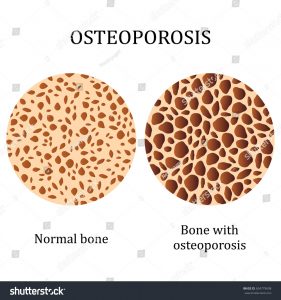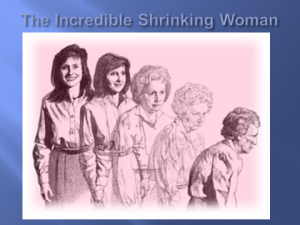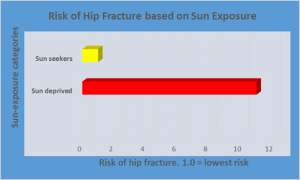 Bone needs vitamin D
Bone needs vitamin D
Bone is deteriorating in our society. Why? Since the year 2000, there has been an 8,300% increase in vitamin D deficiency in children. Insufficient time playing outdoors and/or sunscreen use are the causes of this disaster.[1] It is especially relevant to know that the skin produces vitamin D when it is touched by ultraviolet light (UV). (UV, of course, is a spectrum of sunlight, and of tanning beds and sunlamps.) And, the artificially-lighted environments that most children (and adults) live in, produce no vitamin D for bones. Vitamin D is critical for preventing osteoporosis, a fact that is most noteworthy for this discussion. Without vitamin D, weak bones develop in adults and rickets can develop in children.
Bone strength in children: Rickets is making a comeback.
Rickets is a horrible, disfiguring children’s bone disease. And, before the population became terrified of sun exposure, rickets was at one time considered to be eradicated. Hence, people are surprised to find out that the bones of children are deteriorating. Hence, rickets is making a frightening comeback,[2] it is rearing its ugly head even in sun drenched southern states. That is probably because the children are inside, avoiding the sun and concentrating on their technology. Of course, disuse of the body during this sedentary state also causes loss of calcium, thus causing weakness.
Can “sun supplementation” stop or reverse bone loss?
Therefore, the latest research on UV supplementation is exceptionally important in this world of indoor artificial light. First of all, rats exposed to long–term low-dose ultraviolet irradiation showed an increase in bone formation rate. Furthermore, there was a decrease in resorption (bone breakdown). And, there was an improvement in bone mass content and bone mineral density without any adverse effects on skin.[3] Consequently, this research shows that the concept of ultraviolet light causing skin cancer is incorrect. Also, it corroborates how effective ultraviolet light is in maintaining and increasing bone mass. For example, a Spanish study shows that women who are sun-seekers are protected from bone loss. They have only one/11 the risk of hip fracture as those who avoid the sun.[4]
Bring the UV light inside to protect bone and enhance wellbeing.
In conclusion, this research demonstrated a concept that had never occurred to me. If we can’t bring the children (or adults) out into the sunlight, perhaps we can bring the sunlight inside to them. Also, it seems like a great idea to use low-intensity ultraviolet light indoors for northern climes where sunlight is scarce in the winter. I guarantee that it will also improve moods, reduce seasonal affective disorder and otherwise enhance the health. So remember regular, non-burning sun exposure when you consider a healthful lifestyle.
[1] Basatemur E, Horsfall L, Marston L, Rait G, Sutcliffe A. Trends in the Diagnosis of Vitamin D Deficiency. Pediatrics. 2017 Mar;139(3).
[2] Weisberg P, Scanlon KS, Li R, Cogswell ME. Nutritional rickets among children in the United States: review of cases reported between 1986 and 2003. Am J Clin Nutr 2004;80(6 Suppl):1697S-705S.
[3] Guo R, Du Y, Zhang S, Liu H, Fu Y. The effects of ultraviolet supplementation to the artificial lighting on rats’ bone metabolism, bone mineral density, and skin. J Photochem Photobiol B. 2018 Aug 27;188:12-18.
[4] Larrosa M, Casado E, Gómez A, Moreno M, Berlanga E, Ramón J, Gratacós J. Vitamin D deficiency and related factors in patients with osteoporotic hip fracture. Med Clin (BARC) 2008;130:6-9.
Today I happened to run across research that stunned me while also making me very happy. A study from New Dehli, India has concluded that babies should sunbathe at least 30 minutes weekly.[1] The reason is that most mothers, and their babies are severely vitamin D deficient, and that rickets, which is a vitamin D deficiency disease, is rampant in that country. The authors said that 90% of the vitamin D requirement could be met from sun exposure. That is a strange statement, considering that sun exposure could easily take care of 100% of the vitamin D requirement.
Oher good things to come from this study: the recommendation for the best sunbathing time was between the hours of 10:00 AM and 3:00 PM, exactly the times that most dermatologists say we should avoid like the plague.
A downside of the report was that the scientists recommended on 40% of the body surface to receive sun exposure. Whole-body exposure would have provided a lot more vitamin D and in a much shorter period of time. Another downside was the recommendation to achieve a serum vitamin D level of 20 ng/ml, which is woefully low. They should have recommended at least twice that level.
The report stated that “sunning” the babies would benefit more than 16 million born each year in India.
It is interesting that sometimes it takes a disaster like rickets for the truth to come full-circle and for common sense to prevail. For example, In the 1930s, when the medical community had not yet bought into the sun phobia of today, the Department of Labor printed a pamphlet called Sun for Babies in which they made this statement: “Every mother who wishes her baby to have robust health should give him regular sun baths from early infancy until he is old enough to play in the sun himself. If the sun’s rays are to help the baby grow properly and to prevent rickets, they must fall directly on the skin and tan it.” That would not be popular advice today, and it is likely that any parent practicing “baby tanning” would be arrested for child abuse. Since the 1930’s the dermatological profession has come a long way… in the wrong direction.
Other research related to bone growth in children shows that those who are growth-hormone deficient, and are being treated for that deficiency, grow more rapidly during summer months.[2] In a one-year study using 118 children from 14 countries as subjects, growth was measured and compared to the amount of sun received by the children. Those who were exposed to more sun had faster growth.
The truth will prevail. The advice to keep children out of the sun has been an unmitigated disaster. Just be sure to keep them safe from sunburn.
[1] Research matters. 9/14/17. https://researchmatters.in/shots/infants-should-sunbath-30-minutes-week-recommends-study.
[2] De Leonibus C, Chatelain P, Knight C, Clayton P, Stevens A. Effect of summer daylight exposure and genetic background on growth in growth hormone-deficient children. Pharmacogenomics J. 2015 Oct 27.[Epub ahead of print].
Sun exposure and health… by Dr. Marc Sorenson, Sunlight Institute…
Lack of vitamin D, which is produced by sun exposure, leads to rickets, osteoporosis, osteomalacia and other bone diseases. In addition, research well after the first discovery of vitamin D has shown that vitamin D deficiency and sunlight deprivation also lead to many cancers, heart disease and multiple additional maladies. Now, as the world has modernized, the population is moving indoors, and even in the areas that are sunny throughout the year, sunlight exposure and vitamin D deficiency is increasing, both in rural and urban populations. The bones become so weakened without regular sun exposure, that the slightest movement may cause a fracture. As an example, the mother of an acquaintance of mine—a woman who avoided the sun—turned over in bed one night and broke her hip. Osteoporosis often destroys all quality or life for those who suffer it.
The importance of the sun in maintaining and producing strong bones has been known since antiquity. Dr. Richard Hobday, author of The Healing Sun, writes the following comments along with a history in an online article.[1] “Traditionally, sunlight deprivation has been linked with weak or brittle bones. One of the earliest references to this was made more than two thousand years ago by the Greek historian Herodotus (480-425 BC), who noted a marked difference between the remains of the Egyptian and Persian casualties at the site of battle of Pelusium which took place in 525 BC:
‘At the place where this battle was fought I saw a very odd thing, which the natives had told me about. The bones still lay there, those of the Persian dead separate from those of the Egyptian, just as they were originally divided, and I noticed that the skulls of the Persians were so thin that the merest touch with a pebble will pierce them, but those of the Egyptians, on the other hand, are so tough that it is hardly possible to break them with a blow from a stone. I was told, very credibly, that the reason was that the Egyptians shave their heads from childhood, so that the bone of the skull is indurated by the action of the sun — this is why they hardly ever go bald, baldness being rarer in Egypt than anywhere else. This, then, explains the thickness of their skulls; and the thinness of the Persian’s skulls rests upon a similar principle: namely that they have always worn felt skull -caps, to guard their heads from the sun.’
Herodotus, ‘The Histories’”
And here is a perhaps the transcendent study on hip fracture and sun exposure: research in Spain showed that women who were sun seekers had only about one-eleventh the risk of hip fracture as those who stayed indoors[2] (See the chart below).
That is very powerful evidence of the efficacy of sun in preventing weak bones. In stark contrast to this research are studies done on women who completely avoid the sun and suffer from osteomalacia. Osteomalacia is a soft-bone disease known as adult rickets, resulting from severe vitamin D deficiency, which deficiency prevents bone from properly mineralizing. Women who seldom go outdoors, or who are nearly always fully covered with clothing, have an extremely high incidence of osteomalacia at a very young age, even if they live in geographical areas with abundant sunlight.[3] [4] If one is never exposed to the available sun, the sun will not be able to produce its beneficial effects on the body, so one may as well live at the North Pole.
Sunbed use also is associated with stronger bones and higher vitamin D levels. An excellent study compared 50 people who used sunbeds regularly with 106 who did not.[5] The sunbed group had 90% higher vitamin D, significantly higher bone density and lower PTH levels (high PTH levels are associated with lower bone mass). The users had healthful vitamin D levels of 46 ng/ml [115 nmol/L] compared to only 24 ng/ml [60 nmol/L] for those who did not regularly use sunbeds.
Scientists at one time believed that sunlight and vitamin D were good only for preventing rickets, osteoporosis and other bone weaknesses. That belief has been supplanted by myriad research studies that show the efficacy of both sun exposure and vitamin D repletion on protection against numerous additional diseases. Nevertheless, we should never forget the extraordinary, never-changing value of sun exposure to maintaining a strong skeleton well into old age.
[1]Richard Hobday. The Healing sun: Sunlight, Brittle Bones, and Osteoporosis. http://sunlightenment.com/the-healing-sun-sunlight-brittle-bones-and-osteoporosis/. (accessed February 5, 2016)
[2] Larrosa M, Casado E, Gómez A, Moreno M, Berlanga E, Ramón J, Gratacós J. Vitamin D deficiency and related factors in patients with osteoporotic hip fracture. Med Clin (BARC) 2008;130:6-9.
[3] Sahibzada AS, Khan MS, Javed M. Presentation of osteomalacia in Kohistani women. J Ayub Med Coll Abbottabad 2004;16:63-5
[4] Al-Jurayyan NA, El-Desouki ME, Al-Herbish AS, Al-Mazyad AS, Al-Qhtani MM. Nutritional rickets and osteomalacia in school children and adolescents. Saudi Med J 2002;23:182-85.
[5] Tangpricha V, Turner A, Spina C, Decastro S, Chen TC, Holick MF. Tanning is associated with optimal vitamin D status (serum 25-hydroxyvitamin D concentration) and higher bone mineral density. Am J Clin Nutr. 2004 Dec;80(6):1645-9.
By Marc Sorenson, EdD Sunlight Institute…
Research from Singapore, a very sunny country, demonstrated that 57% of older adults with hip fractures were vitamin D deficient.[1] The researchers note that in Western countries with seasonal winters, D deficiency is common due to the reduction in sunlight. But on measuring serum vitamin D in fracture patients in sunny Singapore, they found that 57.5% were suffering deficiency and 34.5% were suffering insufficiency. Only 8% of the patients had normal vitamin D levels.
One might ask why people residing in a sunny, predominantly tropical climate would have such a high degree of vitamin D deficiency and consequently high fracture risk. Further study found the answer: Most of the people who suffered fractures had been housebound and had little sun exposure. The authors of the paper made the following statement: “Another factor was Malay ethnicity (dark skin, which inhibits vitamin D production), and clothing habits that prevented sun exposure.”
The authors of the paper concluded with this statement: “Vitamin D deficiency and insufficiency are common in patients with hip fracture in Singapore. Vitamin D deficiency was associated with being housebound and those of Malay ethnicity. Clothing habits resulting in reduced sunlight exposure may increase the risk of vitamin D deficiency.”
The same pattern of high D deficiency also exists among youth in some sunny countries; in Qatar deficiency is common. [2] Sixty-eight percent of the children there are deficient and the girls are especially likely to be deficient. Low duration of time spent outdoors is a major predictor of deficiency, and the children who are deficient suffer a greater incidence of rickets, fractures, and gastroenteritis.
And finally, I would like to remind the readers of research from Spain that I have cited on various occasions. Women who spend their time indoors are about 11 times more likely to have a fracture as those who regularly seek the sun.[3]
A major message is this: If the sunlight is all around you and you don’t expose yourself to it, it will do you no good. You may a well live in the Arctic Circle.
Carefully embrace the sun and save your bones.
[1] Ramason R, Selvaganapathi N, Ismail NH, Wong WC, Rajamoney GN, Chong MS. Prevalence of vitamin D deficiency in patients with hip fracture seen in an orthogeriatric service in sunny Singapore. Geriatr Orthop Surg Rehabil. 2014 Jun;5(2):82-6
[2] Bener A, Al-Ali M, Hoffmann GF. High prevalence of vitamin D deficiency in young children in a highly sunny humid country: a global health problem. Minerva Pediatr. 2009 Feb;61(1):15-22.
[3] Larrosa M, Casado E, Gómez A, Moreno M, Berlanga E, Ramón J, Gratacós J. Vitamin D deficiency and related factors in patients with osteoporotic hip fracture. Med Clin (BARC) 2008;130:6-9.
By Marc Sorenson, EdD. Sunlight Institute
In the medical journal Pediatrics, an interesting report discussed the plight of two young girls who suffered from severe tooth decay related to Rickets,[i] a horrific disease caused by vitamin D deficiency. This illness is characterized by defective bone growth and horribly deformed bodies, and, as we will see, it may also be characterized by teeth without enamel.



